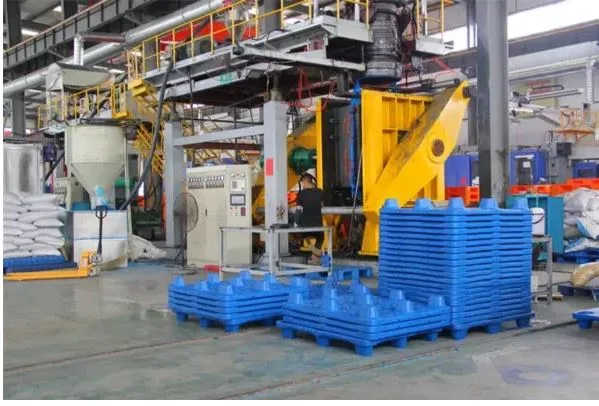Industrial Plastic Pallets: Heavy Duty, Stackable, and Nestable Solutions
In almost every sector of business, industrial plastic pallets are the preferred choice for efficient material handling and storage. Designed to withstand harsh environments, these pallets offer complete durability, versatility, and cost-effectiveness. If heavy-duty pallets are needed to support heavy loads, there are stackable options that help keep warehouse space free, or nestable ones for easy transportation. This article is meant to expand on the advantages industrial plastic pallets offer, discussing their applications in contemporary logistics and storage systems to give you an idea of how these pallets can change the way you do business. Continue reading to understand why they have become a vital supply chain element nowadays. Click here to read more
Introduction to Plastic Pallets
Modern logistics and storage functions require durable and versatile solutions, and plastic pallets fulfill these requirements. Manufactured with top-quality, lightweight materials, they give more strength against moisture, chemicals, or pest entry with respect to standard wooden pallets. Hence, their consistent dimensional configuration assures their reliability in automated systems. Furthermore, these have a wide variety of designs for different applications, whether heavy-duty or easy nesting for apt storage. Plastic pallets are environmentally friendly, reusable, and contribute to maintaining high levels of hygiene. That is why industries such as food manufacturing, pharmaceutical manufacturing, and manual production prefer them.
What Are Plastic Pallets?
Plastic pallets are sturdy yet lightweight platforms made from materials such as polyethylene and polypropylene for the storage and transportation of goods. Unlike wooden pallets, they are moisture- and chemical-resistant and are immune to pests; thus, they may be considered suitable for industries that require high hygienic standards like those of food and pharmaceuticals. Since plastic pallets are made with consistent dimensions and are sufficiently strong, they can safely be utilized on automated handling and storage systems. Plastic pallets are reusable and recyclable, which is beneficial for sustainability and economics compared to their cousins, wood pallets.
Reasons for Choosing Plastic Pallets Over Wooden Ones
Certain advantages are offered by plastic pallets over the wooden variety, especially in situations with high demands on sanitary and durability procedures. They resist moisture, pests, and chemical contaminations, making them appropriate for the handling of sensitive contents, like food and pharmaceutical products. Plastic pallets, being more robust and durable, have a longer life and thus reduce the rate of replacement when compared to wooden pallets. They possess a consistent size and are relatively lightweight, which improves their application in automated machinery and so its smooth logistical maneuvering. Plastic pallets, being recycled and reused, present an environmentally friendly alternative that encourages the industrialization of sustainable practices.
Common Uses for Plastic Pallets
Plastic pallets are used in many industries for their versatility and durability. In the food and beverage industry, where hygiene is paramount, plastic pallets are used because they can be easily cleaned and thus are not easily contaminated. Likewise, in the pharmaceutical industry, they allow sensitive items to be handled safely and securely. Retail and e-commerce industries use plastic pallets for storage and transportation, while heavy-lifting in automotive and manufacturing occurs alongside automated shipments on plastic pallets. Thus, practically, plastic pallets form the crux to streamline logistics and preserve product integrity for countless applications.
Types of Plastic Pallets
Plastic pallets vary. They are presented in various designs and are used according to their design parameters:
Nestable Pallets
Pallets of this type have been designed to conserve space during storage and shipping by way of stacking inside one another when not in use.
Rackable Pallet
Constructed to be strong and durable, rackable pallets are used in racking systems holding heavy loads.
Stackable Pallets
Having a solid bottom, these can be stacked on top of one another safely, hence offering them stable storage.
Export Pallets
Light and cheap, export pallets have been especially designed for one-way shipments and international transit.
Hygienic Pallets
Common to the food and pharmaceutical industry, these pallets have a smooth surface that allows cleaning and ensures strict hygiene standards.
Each variety satisfies the needs for different industries to ensure efficacy and functionality under different applications.
Heavy-Duty Plastic Pallets
Heavy-duty plastic pallets are created for rigorous conditions and harsher treatment, and thus are characterized by heavy loads and repeated use. The pallets remain highly durable, striking against walls and unaffected by moisture, chemicals, or extreme temperatures,” guaranteeing years of durability. They can easily be cleaned and maintained, in line with hygiene standards required in the pharmaceutical and food industries. Due to their strong build and consistent performance, they provide a suitable solution for numerous industries and logistics activities, including storage in warehouses and supply shipments.
Stackable Plastic Pallets
Stackable plastic pallets thus afford a high number of benefits to industries requiring sturdy and reusable options for storage. They are designed to save space by allowing secure stacking, thereby drastically cutting down storage needs. These pallets are lightweight but strong enough to be handled easily and carry heavy loads. High-quality materials have been used to manufacture them to resist wear and tear, corrosion from chemicals, or adverse environmental conditions, thus securing their optimal position in the marketplace for long-term use. Moreover, their standardized design ensures they can work well with automated systems and ease the handling process downstream in the supply chain, which is a great upside for any business set on increasing operational efficiency.
Nestable Plastic Pallets
Nestable plastic pallets are purposely made to optimize storage capacities and simplify logistics. Interestingly, they have a weight-to-load capacity ratio that makes them easy to handle while carrying heavy loads. Due to their sturdy construction, these pallets remain unsullied by wear, moisture, and even temperature changes, thus promising the possibility of long-term sustainment. Using mechanisms, the uniformity of pallets ensures smooth functioning in the supply chain. Therefore, nestable plastic pallets reduce the space for storage and easy transportation, making them a pragmatic choice for cost-conscious entities requiring a cost-efficient solution.
Specifications of Plastic Pallets
Materials: Plastics are generally of high quality and durable, for instance, polyethylene (PE) or polypropylene (PP).
Weight: Constructed lightweight for ease of handling, it typically ranges from 10 to 25 lbs, depending on size and type.
Load Capacity: Ability to bear a static load of 5,000 lbs and a dynamic load of 2,500 lbs.
Dimensions: Common dimensions are 48×40 inches for standard usage, with options for customization.
Design: The design allows nesting or stacking to impart higher space efficiency. Some may incorporate reinforced structural considerations for non-slip surfaces.
Compatibility: These are designed for easy use in tandem with forklifts, pallet jacks, and automated systems.
Durability: Moisture, chemicals, and temperature fluctuations-resistant, guaranteeing long-term reliability.
Recyclable: Made from recyclable material, supporting efforts towards sustainability.
Such specifications illustrate the versatility and the use of plastic pallets across different industries.
Dimensions: 48×40 and 48×48 Options
The 48×40 and 48×48 dimensions, being important for plastic pallets, go through various applications in industries like manufacturing, warehousing, and distribution. The 48×40 sizes have become very popular since most shipping and storage systems are standardized for their use, while 48×48 sizes provide extra surface space for mounting bigger items or bulky loads. These two sizes maintain equal durability, load capacity, and ergonomic features so they can fit well into the current systems and operations. These pallets give the possibility of meeting different logistical needs without compromising with industry standards.
Weight Capacities and Durability
A weight capacity on a pallet is an indispensable element to consider in the sectors of logistics and warehousing. Both the 40×48 and 48×48 pallet dimensions offer high load capacities, often several thousand pounds, to suit different applications. Constructed from heavy-duty plastics or reinforced wood, such pallets can take the wear and tear of repeated use, environmental abuse, and the rough handling of heavy equipment. The award of reliability can yield in the long term, as one does not have to replace a pallet repeatedly, ensuring that operations run smoothly.
Material Handling Features
Since multiple materials-handling operations require high-performance pallets, they must be designed to work with forklift trucks and pallet jacks for smooth transportation across warehouses and dock loading areas. Usually, ventilated decks are present to enhance air circulation, which is a requirement for perishables. They are usually stackable and nestable for space optimization when not in use. Anti-slip surfaces can be integrated within the design to ensure that loads do not shift during transit, to keep safe and remain stable. All these features help maximize efficient operation while minimizing any chance of damage to the products.
Rackable and Export Pallets
Rackable pallets are meant to be used in super-storage settings where strength and stability come first. They can hold heavy loads when placed on racks and will never bend or break. The pallets are usually made of heavy-duty materials to ensure strength, such as plastic and metal.
Export pallets, on the other hand, weigh less and serve as a cheap way of shipping goods internationally. They are generally made out of treated wood, plastic, or cardboard, in compliance with international shipping standards (like ISPM-15 for wood pallets). Export pallets are meant to be used very few times, making them an economical mode of transportation that does not require back-hauling.
About Rackable Plastic Pallets
The list of capabilities: They are tough, durable, and therefore suitable for material handling, bearing placement of loads on racks with no fear of bending or breaking. These pallets are made of HDPE or polypropylene so they can support heavy weights and still retain structural integrity. Perfect for long-term applications, they are resistant to moisture, chemicals, and impact. Rackable plastic pallets are also hygienic and easy to clean, meeting the standards required by the food, pharmaceutical, and other sensitive sectors. Being able to push a heavier burden into space, they end up being perfect cost-wise and sustainable for the logistics and warehousing needs of tomorrow.
Benefits of Nestable Export Pallets
Nestable Export Pallets come with certain advantages that make them the preferred option for international freight and storage. With a compact design, these pallets allow for nesting, reducing considerable space consumption while maintaining logistics costs. Light and durable, these export pallets help support a load’s stability while minimizing shipping expenses. These environmentally friendly export pallets are made with top-class recyclable materials that meet global shipping requirements. They are resistant to pests and moisture; hence, no fumigation is necessary. That eases international regulation compliance. Therefore, nestable export pallets offer a lower-cost, faster, and greener solution for global logistics operations.
Choosing a suitable export pallet according to your needs
When selecting an export pallet suitable for your needs, consider several factors, such as the type of goods to be transported, the weight and dimensions of the load, and the shipping regulations of the destination. For cargo, lightweight, and non-fragile, plastic nestable pallets are an economical and durable solution. Cases of heavy or fragile shipments may require pallets with extra strength or protective capability; always make sure that such pallets conform to international regulations like ISPM-15, 15 since non-conformity could land you in trouble during transit. Also, be environmentally conscious by choosing materials that can be recycled or reused. Therefore, the final consideration of all these aspects will lead to the selection of pallets that satisfy logistics and sustainability criteria.
Conclusion
Future Trends in Plastic Pallet Usage
So, the future will definitely think about advancements in material innovation, automation, and sustainability in the use of plastic pallets. In keeping with the green trend, manufacturers went into recycled and bio-based plastics to lessen their environmental impact. Therefore, these plastic pallets will also be RFID and IoT-integrated in their own ways to promote tracking and monitoring of the products for better supply chain visibility and efficiency. Due to the strength and uniform designs of plastic pallets, they will be preferable for advanced systems in automated warehouses and robotics. These combined trends indicate that the next few years will mark a shift towards smarter, sustainable, and technology-integrated pallet solutions.
Conclusion and Recommendations
To better address future supply chain and logistics needs, plastic pallets will be invested in for sustainable, durable, and innovative purposes. Sustainability requires that we favor suppliers who purchase materials and use environmentally friendly manufacturing processes. Further, the pallets should be RFID- or IoT-enabled to maximize their tracking and monitoring capabilities. Having adopted automated warehouses, choosing standardized plastic pallets designed for robotics and advanced systems will enhance operational efficiency. These moves will therefore enable your operations to adjust to the ever-changing industry landscape while advancing environmental consciousness.
Frequently Asked Questions (FAQs)
What are some benefits of using heavy-duty plastic pallets?
Heavy-duty plastic pallets are structurally designed to withstand high impact, offering durability and strength for all possible industrial applications. Typically, they are made of high-density polyethylene, which is resistant to moisture and chemicals and does not splinter. Heavy-duty plastic pallets withstand the rigors of material handling and shipping, ensuring your products are secure during transport. Unlike wooden pallets, heavy-duty plastic pallets require no upkeep and are consequently the least expensive alternative over time. A heavy-duty plastic pallet is also suitable for many cycles of use, making it a green alternative. Therefore, heavy-duty plastic pallets should be an obvious consideration to companies looking for reliable and long-lasting palletizing solutions.
What makes a top plastic pallet suitable for grocery distribution?
A typical top plastic pallet, suitable for grocery distribution, features a solid design that prevents items, especially smaller ones, from falling through during relocation. They are hygienic and easy to clean, which is an essential factor to consider in the food industry. A large number of top plastic pallets are stackable, allowing them to be stored efficiently in limited spaces. They are also made from materials that pass food safety regulations, thereby making them safe to use with edible items. Moreover, being lightweight allows them to minimize shipping costs, making them a cheaper option in grocery distribution. In all, top plastic pallets provide a convenient and efficient option in carrying food items.
What are the advantages of purchasing reusable pallets?
The reusable pallet offers great advantages to businesses wishing to improve their shipping and handling operations. Unlike single-use pallets, these have been prepared for shipment for multiple trips, thereby reducing waste and enhancing sustainability. Cemented with hard materials, they remain strong despite the weather conditions that work against them during the operational life of such structures. Moreover, customizations can be made to fit specific product dimensions, which gives them more utility in different industries. Such pallets offer a slight advantage in cost reduction because a company minimizes rather than increases pallet purchases when using these pallets. Overall, the reusable pallet would undoubtedly be an efficient and environmentally-friendly choice for the modern supply chain.
What makes solid top plastic pallets different from smooth top ones?
The two designs are targeted at different uses. Because of the continuous top, solid pallet tops prevent smaller items from falling through and may therefore be used for either smaller boxes or liquids. On the other hand, smooth top pallets are flat and hence easy to clean, and they are mainly used in industries where hygiene is paramount. Both types come with others: they’re lightweight, durable, and resistant to moisture and chemicals. Choosing between a solid and smooth top depends entirely on the business’s product requirements and handling needs. Both are good choices for enhancing logistics efficiency.
What are some qualities of a drum pallet?
Drum pallets are made to keep drums and barrels safe for storage and transportation. Usually, these pallets have some sort of cradle or rim to contain any spill and lock the drum in for safe transfer. Drum pallets are commonly made from either high-density polyethylene or structural foam, resisting chemical attacks while providing strength. Many drum pallets are stackable, optimizing warehouse space. Besides, they are useful in a range of environments, both industrial and commercial. In total, drum pallets are a necessity for any liquid material company, enhancing safety and compliance.






